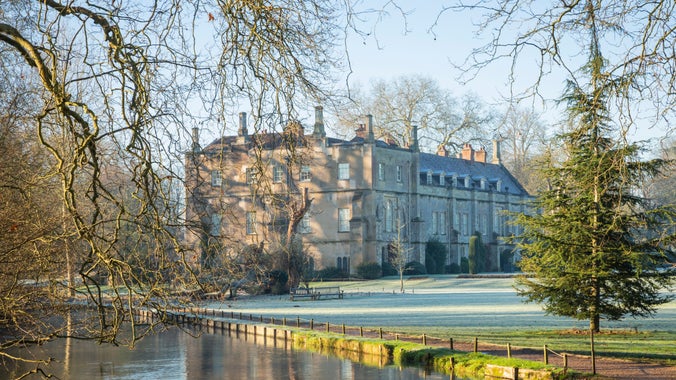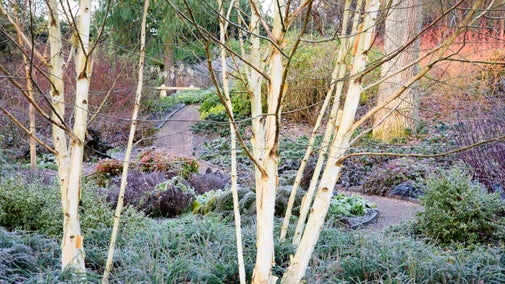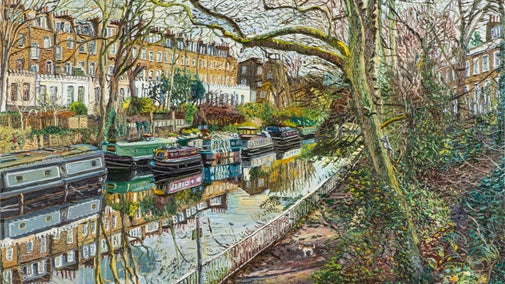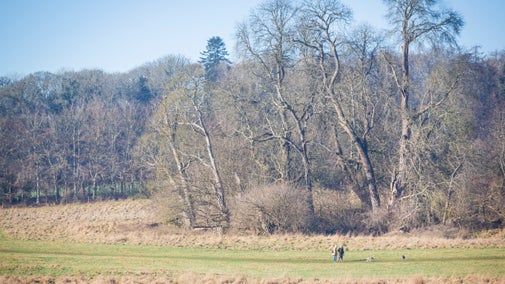
Become a member
Join today and help protect nature, beauty and history – for everyone, for ever. Enjoy access to more than 500 places with National Trust membership.
A romantic house and gallery set in beautiful riverside gardens
near Romsey, Hampshire, SO51 0LP

| Asset | Opening time |
|---|---|
| Garden | 10:00 - 16:00 |
| Art gallery | Closed |
| House | Closed |
| Café | 10:00 - 15:45 |
| Shop | 10:00 - 16:00 |
| Play area | 10:00 - 16:00 |
Please note: Last entry is 30 minutes before the listed closing times.
| Ticket type | With Gift Aid | Without Gift Aid |
|---|---|---|
| Adult (18+) | £12.10 | £11.00 |
| Child (5-17) under 5s free | £6.10 | £5.50 |
| Family (2 Adults and up to 3 children) | £30.30 | £27.50 |
| 1 adult, 2 children | £18.20 | £16.50 |
| Group (Adult 18+) | £19.00 | |
| Group (Child 5-17) | £9.50 |
| Ticket type | With Gift Aid | Without Gift Aid |
|---|---|---|
| Adult (18+) | £25.30 | £23.00 |
| Child (5-17) under 5s free | £12.70 | £11.50 |
| Family (2 Adults and up to 3 children) | £63.30 | £57.50 |
| 1 adult, up to 3 children | £38.00 | £34.50 |
| Group (Adult 18+) | £21.85 |
| Ticket type | With Gift Aid | Without Gift Aid |
|---|---|---|
| Adult (18+) | £24.20 | £22.00 |
| Child (5-17) under 5s free | £12.10 | £11.00 |
| Family (2 Adults and up to 3 children) | £60.50 | £55.00 |
| 1 adult, 2 children | £36.30 | £33.00 |
| Group (Adult 18+) | £20.90 |
The Wild Play area includes three large wooden structures built for climbing, balancing and exploring.
Second-hand bookshop located in the Stables
Old Kitchen Café and Coach House Café open daily, and additional facilities during busy periods
Free parking in car park adjacent to the welcome centre. Please do not park on roadsides or verges in Mottisfont village as this can block access for emergency vehicles
Dogs on leads welcome in most of the gardens and the wider estate. Dog-friendly indoor café area in the Stables. Assistance dogs only in the walled gardens, formal lawns behind and in front of the house, and the Old Kitchen Café
Ten electric vehicle charging outlets available in the main car park. Chargers can be accessed via mobile app, RFID card or contactless payment device. Visit our EV charging partner, RAW Charging's website (www.rawcharging.com/drivers) to download the app before your visit. Chargers only available during property opening hours. User helpline: 020 7519 5052.
Volunteer-led guided garden walks are available on select days. Please ask at Reception which tours are available today.
The walled garden kiosk opens in summer from 10am - 4pm.
There are picnic benches on both the north and south paddocks, with accessible picnic tables located near the shepherd's hut in the north paddock.
Open daily, located next to the shop in the welcome centre
Open daily, located in the welcome centre
We have toilet facilities available at the Welcome Centre, Stables, and Kitchen Garden. In the lower corridor of the house, we have restricted toilets available for Gents, Access, and Baby Change. Unfortunately, the ladies' toilets are currently unavailable due to plumbing and floor issues, which we are actively investigating.
Blue Badge parking and drop-off point. Wheelchairs available. Buggy service. Accessible toilets. Slopes and uneven pathways. Ramped or level entrances
Facilities available in the welcome centre, the ground floor of the house, the stables and kitchen garden. Toilets equipped with alarm pull cords that alert staff if assistance is required
20 spaces located close to the accessible ramp into the welcome centre
Outside the welcome centre entrance
Benches situated throughout the garden and grounds
The property is situated on a gentle slope. Paths are mostly wide and surfaced with a mix of stone and clay which is uneven in places, and can be muddy during wet weather. Exposed tree roots on riverside pathways
Volunteer-driven mobility buggy service available on request for transport between the welcome centre, house entrance, stable yard (including Coach House Café), and entrance to the walled gardens
Five manual wheelchairs available from the welcome centre on a first come first served basis
Mottisfont offers a fantastic family day out, with something for everyone. As well as the wild play area, scenic river and meadow, there are specially-designed activities for pre-schoolers and exciting events every school holiday. Enjoy perfect winter picnic spots, delicious treats from our cafés, and convenient baby-changing facilities - all in a beautiful, welcoming environment.

Mottisfont is a two pawprint rated place. Dogs on a short lead are welcome to explore most of the garden.

Whether you're looking to take in one of the exhibitions, discover Mottisfont’s history or simply stroll through beautiful gardens, we'll ensure that your group has a great day out.

Explore Maud Russell’s 1930s neo-classical interiors, in an 18th-century house with medieval origins and enjoy changing art exhibitions in the spacious gallery.

Enjoy every season at Mottisfont, with its ancient trees and babbling brooks, from rich autumn foliage and the scented Winter Garden to snowdrops, the first harbingers of spring and, of course, the world-famous Rose Garden.

We've got some delicious and healthy treats to keep spirits and energy levels up during the cold winter months.

18th-century house with medieval priory at its heart, which was transformed into a Neo-classical home in the 1930s
Permanent collection of 20th-century art on display in the house and changing exhibitions in second-floor gallery
Riverside walkways and an ancient spring. Magnificent trees, seasonal planting, and significant collection of roses that flower in early summer
Enjoy winter walks of wildlife and flora-rich countryside at Mottisfont and beyond. Explore Hampshire’s stunning seasonal landscapes, from woodland walks, the marshes and downlands of Stockbridge, discover the New Forest and the natural beauty of Curbridge Nature Reserve.
Wooden climbing frames, platforms and balance beams
Treat yourself after a walk around the gardens with a hot drink or light lunch at one of our cafes.
Explore our selection of local products in the Shop and gardening resources in the Plant Centre, located in the Welcome Centre.
Tucked away in the corner of the stables, you will find our second-hand bookshop, stocked with hundreds of pre-loved books, spanning all genres and containing a good read for all ages.
Mottisfont offers a fantastic family day out, with something for everyone. As well as the wild play area, scenic river and meadow, there are specially-designed activities for pre-schoolers and exciting events every school holiday. Enjoy perfect winter picnic spots, delicious treats from our cafés, and convenient baby-changing facilities - all in a beautiful, welcoming environment.

From 17 January to 22 February, delight in these beautiful heralds of spring with a variety of snowdrop-inspired activities.

From 19 January to 15 March, join us for an enchanting journey inspired by Eric Carle’s beloved children’s book, The Very Hungry Caterpillar™. This charming trail brings to life the best-selling story of the tiny caterpillar who hatches from an egg and is so hungry he eats through a variety of fruits and snacks each day. Enhanced by illustrated trail markers, activities and games, this activity-packed trail is perfect for children aged 3-6 years.

24 January to 12 April: View the changing seasons through the lens of three very different contemporary artists. This new exhibition in the Gallery at Mottisfont celebrates the beauty and power of nature in over 60 cityscape and landscape paintings.

Explore Maud Russell’s 1930s neo-classical interiors, in an 18th-century house with medieval origins and enjoy changing art exhibitions in the spacious gallery.

Enjoy every season at Mottisfont, with its ancient trees and babbling brooks, from rich autumn foliage and the scented Winter Garden to snowdrops, the first harbingers of spring and, of course, the world-famous Rose Garden.

Explore Mottisfont’s diverse estate, criss-crossed by the crystal-clear River Test, and south Hampshire countryside sites of Stockbridge Down and Marsh and Curbridge Nature Reserve.

We've got some delicious and healthy treats to keep spirits and energy levels up during the cold winter months.

Discover our beautiful sustainably-sourced fashion and homeware items as well as children's pocket money toys, books and beautiful stationery. Explore our range of local products, from handcrafted soaps and hand creams to unique jewellery and beverages. The plant centre has winter plants and vibrant spring bulbs to brighten up your garden while the second-hand bookshop at Mottisfont offers a wide range of genres too.

Discover the beautiful, diverse Mottisfont estate on a varied circular walk through ancient woodlands, historic farmland and Mottisfont village.

From 17 January to 22 February we will be celebrating snowdrop season as hundreds of these harbingers of spring start to emerge across Mottisfont.
Join us for an enchanting journey inspired by Eric Carle’s beloved children’s book, The Very Hungry Caterpillar™. Through this captivating trail, little ones can experience one of nature’s greatest transformations. Runs 19 January to 15 March.
Mottisfont begins its 2026 exhibition season with a show that reflects the idiosyncratic beauty of Britain’s seasons as they transform our landscapes and townscapes, seen through the eyes of three contemporary artists.
Join in with simple self-led activities aimed at pre-schoolers, to enjoy while you explore the gardens.
Join in with simple self-led activities aimed at pre-schoolers, to enjoy while you explore the gardens.
Join in with simple self-led activities aimed at pre-schoolers, to enjoy while you explore the gardens.
Hop into Easter excitement at Mottisfont! From 21 March to 12 April enjoy an activity-packed Easter trail full of family fun.
Ancient trees, bubbling brooks and rolling lawns frame this 18th-century house with a medieval priory at its heart.
Maud Russell made Mottisfont her home in the 1930s, bringing artists here to relax and create works inspired by Mottisfont’s past, including an extraordinary drawing-room painted by Rex Whistler. We continue those artistic traditions today, with a permanent 20th-century art collection and major exhibitions in our top-floor gallery.
Outside, carpets of spring bulbs, a stunning walled rose garden, rich autumn leaves and a colourful winter garden make Mottisfont a feast for the senses all year round. Our world-famous collection of old-fashioned roses flowers once a year in June. Winding paths meander through stately trees, with the sound of water never far away.
There’s space to run, jump and play, and always something for families to do.
We also look after 1600 acres of woodland and tenanted farmland in the local area, including Stockbridge Down and Marsh, and Curbridge Nature Reserve. Our wider estate is a wonderful place to explore, take a relaxing walk and take in the sights of some of Hampshire's most glorious countryside.
Discover Mottisfont’s eight centuries of history and transformation. From medieval priory to the 18th-century structure, housing Maud Russell’s stylish 20th-century redevelopment.

Explore the objects and works of art we care for at Mottisfont on the National Trust Collections website.

We make compost in vast quantities at Mottisfont, keeping the soil healthy and ensuring the garden, including the famous rose collection, is looking its very best.

Our work managing Mottisfont’s river and woodlands aims to create a wildlife-rich habitat, find out more about how we care for the estate.

We’re doing lots of work to look after the countryside sites of Stockbridge Down, Stockbridge Marsh and Curbridge Nature Reserve in order to provide key habitats for rare species.

As part of the International National Trust Organisation’s Withstanding Change project, National Trust teams at Hinton Ampner and Mottisfont in Hampshire have been working closely with Heritage Watch Ethiopia to learn about adapting their gardens to climate change.

Find out how you could join us - whether you're looking to make new friends, develop skills or simply want to be part of something you're passionate about.


Join today and help protect nature, beauty and history – for everyone, for ever. Enjoy access to more than 500 places with National Trust membership.
By sharing your email address you’re agreeing to receive marketing emails from the National Trust and confirm you’re 18 years old or over. Please see our for more information on how we look after your personal data.